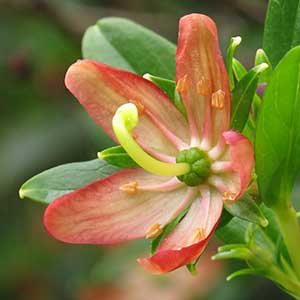Elliottia pyroliflora
Elliottia racemosa
copperbush
Georgia-plume
alternate or seemingly whorled at ends of twigs;
petiole 1–4 mm;
blade elliptic to oblanceolate, (1.5–)2–5 × 0.6–1.4 cm, base cuneate, margins flat, apex mucronate, surfaces glaucous.
alternate;
petiole 6–14 mm;
blade ovate to elliptic, 5–12 × 2–4.5 cm, base cuneate, margins flat, apex acute to acuminate, mucronate, abaxial surface sparsely hairy, especially on veins, adaxial surface green.
terminal, solitary flowers or 2–3-flowered cymes, 2–4 cm;
bracts leaflike, lanceolate, 10–15 mm, margins entire.
terminal, (10–)40–80-flowered racemes or panicles (branches to 5 cm), (5–)10–20(–28) cm;
bracts (deciduous before anthesis), scalelike, linear to ligulate, 2–3 mm, margins ciliate.
5–10 mm, with 1–2, persistent bracteoles distally.
10–20 mm, with 2 deciduous, minute bracteoles proximally.
calyx lobes 5, lanceolate, 7–10 × 2–4 mm, apex acute, ciliate along margins especially basally;
corolla 5-lobed, petals pinkish or copper colored, narrowly elliptic, 10–15 mm;
stamens 8(–10);
filaments glabrous;
anthers 1.7–2 mm;
style (persisting in fruit), curved or recurved, 10–12 mm.
calyx lobes 5, broadly deltate, 1–1.5 × 1–1.2 mm, apex subacute, with short, stiff hairs;
corolla 4–5-lobed, petals white, narrowly elliptic to spatulate, 9–10(–14) mm;
stamens 10;
filaments 4–5 mm, glabrous;
anthers 0.7–1 mm;
style (not persisting in fruit), straight to slightly curved (not recurved), 7–10 mm.
5–6-parted, spheroidal, 5–8 mm, finely pitted, glabrous.
oblate-spheroidal, 4–5-parted, 7–12 mm wide, inconspicuously verrucose.
0.5–0.8 mm, testa with conspicuous cells.
ca. 50–100, 2–2.5 mm.
= 22.
= 22.
Elliottia pyroliflora
Elliottia racemosa
Elliottia pyroliflora has a wider geographic and elevational range than E. racemosa; it is considered difficult to grow.
(Discussion copyrighted by Flora of North America; reprinted with permission.)
Of conservation concern.
Although Elliottia racemosa is rare and localized, it occurs in a wide variety of sandy soil conditions ranging from moist to extremely dry (T. S. Patrick et al., www.georgiawildlife.com). About 70 sites are known in Georgia, and one historic site in South Carolina. The locations in Georgia are mostly within the Altamaha-Ogeechee-Savannah river drainage system. The leaves turn an attractive bright red in autumn. Georgia-plume has been in cultivation since 1813, and is hardy as far north as New England. It is considered to be difficult to grow and prone to fungal diseases (R. Determan, pers. comm.).
(Discussion copyrighted by Flora of North America; reprinted with permission.)
- Local floras:
BC,
OR,
WA
- Local Web sites:
Flora NW,
PNW Herbaria
WildflowerSearch
iNaturalist (observations)
USDA Plants Database
- LBJ Wildflower Center
- SEINet
- Plants of the World Online
- Encyclopedia of Life
- Wikipedia
- Google Image Search


